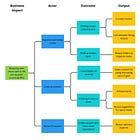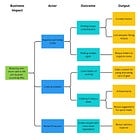When not to start with Impact Mapping
As with all mapping methods, Impact Mapping has its time and place. But it doesn’t fit any situation.
So let’s explore situations when Impact Mapping is maybe not the best choice.
Lack of defined Business Impact
The most obvious is if you don't have clarity on what Business Impact your organization is looking for. A single team in a larger organization won’t be able to define the Business Impact without the context and buy-in from senior management. Impact Maps can help to get commitment and clarity on the expected Business Impact. But require somebody in the room who can decide where to focus, and more importantly, this person must be able to defend this focus from other distractions.
If the strategic alignment is not given and a clear metric of Business Impact is fuzzy, I wouldn’t start with Impact Mapping. I would instead go into Northstar Framework/Metrics, KPI Trees, and other methods to get foundational indicators on how the organization is measuring its success.
No User/Stakeholder Insights
Another less obvious blocker for starting Impact Mapping is the lack of real-life insights about your user base and other actors. If you are not regularly engaging with customers, users, regulators, etc., you will introduce too many assumptions. Yes, we will introduce a lot of assumptions while mapping, and no, we don’t have to research anything beforehand. But if the people doing the Impact Mapping never saw any real Actor, how should they know what they need?
If this is your situation, start your Impact Mapping session with a series of interviews to get some real input. And if you have some quantitative insights, add this information on top. But it is better to start getting your user input muscle up before trying to act on user insights.
Wrong group size or participants
This is more of a tip for planning your session. Don’t try to do this kind of session with a big group. I usually wouldn’t do this session with more than ten people. The ideal size would be around five participants. If there are too many people, some of them will check out. There will be too many discussions in the room. Everything will take ages. If you have no choice, split the group and let them recombine their maps.
Additionally, you want a good mix of roles in the room. You want somebody who understands the business perspective. You want people who can argue from technical standpoints. You want views from customers, users, and other influences. And be sure that the real decision-makers are present. Without them, you will run in circles. For a team setup, this might be the Product Manager. From a high-level perspective, this might even be the CEO.
That means you shouldn’t do this alone. The goal is to get a lot of options and perspectives in front of the group. The conversation is more valuable than the artifact itself. So, please don’t map alone without any input.





